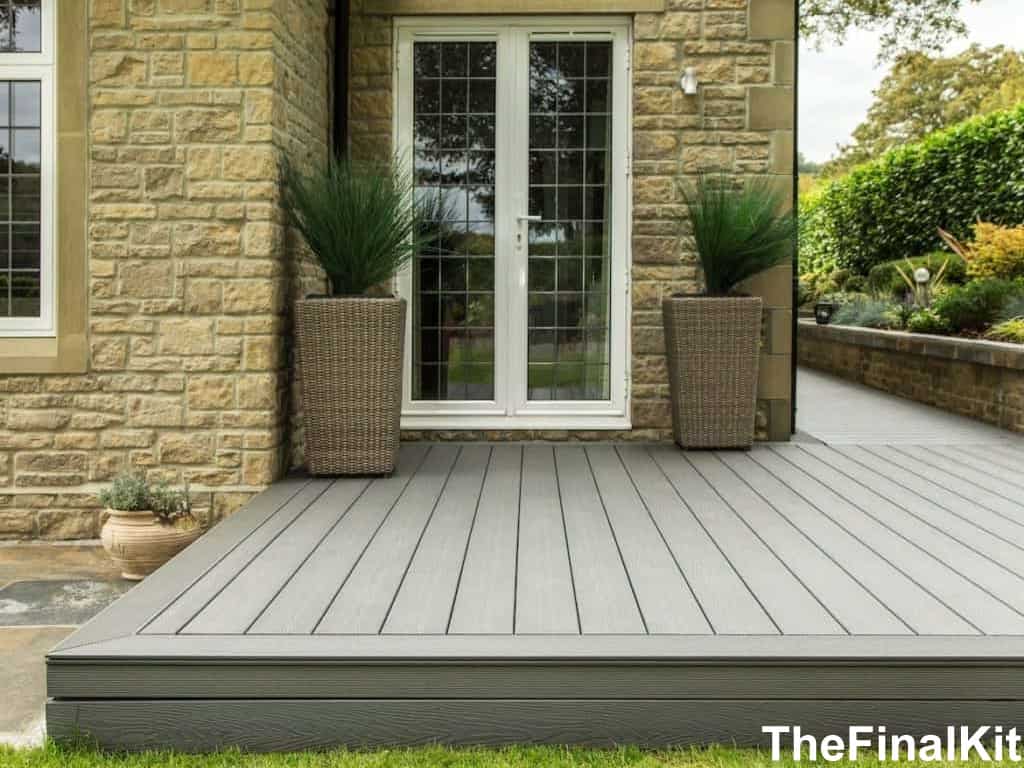The contrast between grooved vs ungrooved composite decking is in their fixation. Both types of composite decking are affixed to the deck in different ways.
Let us delve deeper and understand the comparison between the two variants of composite decking. They both serve the same purpose, to build strong and resilient deck flooring.
No one can say which type of decking is better than the other; customers who want flooring with a solid build go for ungrooved decking.
On the contrary, some like grooved decks with channels along their sides. If you are unsure about what type of decking to choose for your home, we will help you decide which is more suitable in this article.
Grooved vs ungrooved composite decking
People appreciate having various deck flooring depending on their landscape, weather, usage, and style. Using natural and unnatural materials for flooring is also a personal preference;
however, using composite lumber is more cost-effective in the long run due to its resilient properties. This material is a wood and plastic product, giving the customer the best of both worlds.

Although many options are available in the market for composite flooring, the most popular ones are grooved vs. ungrooved composite decking.
Both types of flooring differ in their properties, appearance, and how they are installed. Moreover, customers prefer one category of composite decking over another due to the amazing price of each type of decking.
Installation
Initially, only wooden floorboards were fixed to the baseboards to serve as flooring. As time passed, newer and advanced forms of flooring were invented to make life easier. As stated above, the two types of composite decking vary in their fixation method. The fixer will still need screws and nails to attach the decking, but one method is more visually appealing than the other.
Customers who want a clear finish without any screws or nails marring the deck’s look can opt for grooved decking. In such type of flooring, no fasteners or clamps are used.
The customer has to bear the additional cost of purchasing fasteners separately for the grooved floors. Then screws or nails are fixed using these fasteners to keep them hidden from sight, resulting in a better-finished product.
The ungrooved decks are fixed using surface fasteners. On the other hand, ungrooved fasteners are perfect for people who do not mind a little nail or screw visible on the deck.
These nails don’t need to create a vividly unappealing presentation, but some might be out of alignment here and there.

In ungrooved composite decking, the work is done faster and requires less cost than the other. One must check with the manufacturer whether they have the certain type of decking board that the customer wants because some producers have grooved decks but do not stock ungrooved ones and vice versa.
Aesthetics
Composite decking has taken the world by storm due to its robustness and higher product quality. The overall look and design of composite decking are the same as wooden flooring, but they are built to last all weather conditions.
They offer qualities of wood and plastic combined in the same floorboard and have a long life than wooden decks.
Both grooved and ungrooved composite decking will have a finish like wooden flooring, with the same built-in grain in the boards as we see in conventional floorboards.
Ungrooved decking will be flat like wood on all sides, confusing a naïve person with the traditional wooden flooring.
But on the contrary, the grooved floorings are slotted on either side. These grooves help to fasten these decks with the help of hidden fixtures.
Even with the hollow channels flowing inside the grooved planks, these decks guarantee the same durability as ungrooved ones.
Where to Use Grooved and Ungrooved Decking?
Understanding grooved vs. ungrooved composite decking implies that we decode in which conditions use one type of decking better than the other.
Although both are highly durable and guarantee a long life, some situations suggest using a certain type of decking is better.
For instance, ungrooved decks are preferable in situations where the builder has to get the work done at a very fast pace.
The visible screws and nails do not appear groggy as some customers like; then ungrooved decking is a good choice for building a durable deck floor.
Secondly, ungrooved composite decks are perfect in cases where the builder wants to construct a multi-tier deck.
They will hold better and entail a reliable finish for the story on a higher level. We recommend using ungrooved decking in areas with a high precipitation ratio all year round. There is no space between the boards, and the water easily drains below, leaving the deck dry.
Like ungrooved decking, grooved decking is also preferred for use in several situations. If the customer wants a neat, clean finish to the final product, without a trace of nails or screws on the decking boards, go for the grooved decking. They may be a little more difficult the install than the traditional flooring, but it’s worth the hassle.

The spaces between the grooved panels have another added advantage apart from hidden installation. Having grooves underneath the floorboard of the deck improves better airflow, thus reducing the growth of mold and moisture underneath the surface.
Cleaning
No matter which type of composite decking one chooses for the deck, cleaning the deck boards is crucial. There is a gap between the grooved decking boards; this gap entails dirt and dust accumulating in the hollow spaces over time. Wind may carry leaves or seeds out in the open, taking refuge in these gaps.
If the homeowner does not invest time and energy in the cleaning of these boards, the growth of living organisms inside the board and the water that seeps inside the empty spaces can cause problems in the longer run. The deck might be damaged from moisture and lose its perfect finish.
We have seen customers complain about the deck giving away if the user does not take care of its cleaning. Take necessary tools to get rid of the remnants of the decking boards to ensure their longevity.
Cost
Budgeting and cost are important features when it comes to construction. One has to keep in mind every way to reduce the overall cost of a constructed unit.
When comparing the pricing factor of grooved and ungrooved composite decking, we know that there is a visible difference between the two categories of decking.
The cost of ungrooved composite decking is higher when compared to grooved decks. The solid floorboards are heavier and bear a higher price tag.
On the other hand, although a grooved floorboard costs less, the builder must also add the hidden cost of purchasing fasteners to attach the deck distinctively.
Before making a purchase, do your math and calculate the overall cost of installing a deck floor. If you are on a tight budget, we encourage you to make a sensible choice when selecting the best composite decking.
Conclusion
We have helped to understand why one type of composite decking differs from another and what features make them unique.
Each has a different fan base due to the list of merits and demerits they bring along. The choice of grooved vs ungrooved composite decking lies solely in the customer’s hands.
It depends on your aesthetic sense and building requirements of the decking one selected for the deck at home.



